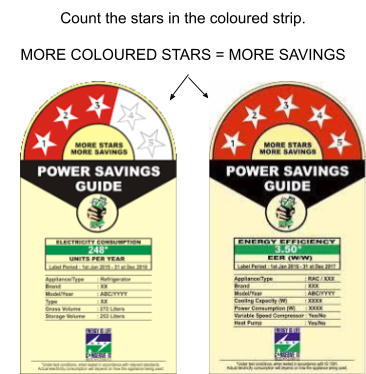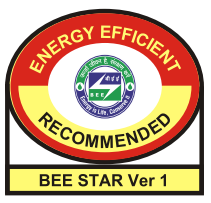Ever since the Industrial Revolution, our reliance on machines has been growing. 21st century machines are powered by electricity, an energy source still dominantly produced by fossil fuels. As human activity (especially human consumption) increases fossil fuels are becoming increasingly scarce. Depletion of non-renewable sources of energy at alarming rates and their implication in greenhouse gas emissions has pushed us to find alternative energy sources and ways to conserve available energy.
To address the existing energy crisis and rising overall demand, energy efficiency is considered the ‘first fuel’ as it is the cleanest and, in most cases, the cheapest way to meet our energy needs. ‘Energy efficiency’ is the application of less energy to produce the same output. The ‘negawatt’ energy ( the amount of energy saved by conservation measures) generated by efficient practices can be used for alternative purposes.
Energy standard and labelling programs are measures employed by manufacturers and policy makers to help consumers understand the energy efficiency of an appliance and shop accordingly. These programs benefit the country by reducing carbon emissions on the one hand while raising consumer awareness on the other.
What are energy standards?
Energy standards prescribe the energy performance of appliances. They lay the regulations for the production of energy efficient appliances. Energy standards can work by prescribing the minimum energy performance of a product, or by mandating a particular feature, for example-minimum air delivery of ceiling fans, to ensure uniform energy performances.
What are energy labels?
An energy label discloses the energy consumption information of an appliance. It helps consumers identify energy efficient equipment. Unique features like colour, characters, stars etc are used in labels to convey the performance level and grade of respective appliance/equipment. The voluntary “energy boy” label of Korea and our own “Star Labels” are great representative examples.

Korea’s energy boy label | Korea Energy Agency
Statutory provisions of the Standards and Labelling scheme:
The origins of energy efficiency in India can be traced back to 1970 when the Fuel Policy Committee (FPC) was constituted to devise a national fuel policy. The FPC introduced the concept of efficient use of fuel. In 2001, the Government of India passed the Energy Conservation Act, 2001 (from here on called the Act) to implement policies/programmes for energy conservation and efficiency in the nation.
The Standards and Labelling (S&L) scheme falls within the purview of this Act and, under Section 14(a) to (c) of the Act, 2001 the Central Government is given powers to notify norms for processes and energy consumption standards for an equipment or appliance. Section 14(d) directs the display of such particulars on a label on the equipment, as per regulations.
The Bureau of Energy Efficiency (BEE) is the implementing agency constituted under Section 3 of the Act. One of its functions is to develop testing and establish certification procedures for energy consumption of equipment and appliances in addition to promoting these testing facilities (s.13(i)). Thus, to fulfil this objective Standards and Labelling program was launched on May 18, 2006.
BEE Labels:
The amount and quality of information conveyed by the energy labels determines its usefulness to the consumers. Under the S&L program, BEE India issues two kinds of labels - the comparative star rating labels and the endorsement labels.
In the comparative star rating label, a star rating, ranging from 1 to 5 in the ascending order of energy efficiency is provided to appliances registered with the BEE. The star label provides details such as the unique identification number of the manufacturer, star rating, energy performance values, label period and the BEE logo. These details can be used to compare the energy efficiencies of different models of appliances available in the market, to make an informed decision.

Star Label & Components | BEE

3 star & 5 star label - A comparison
The endorsement label defines a group of appliances as efficient when they meet the “Minimum Energy Performance Standards (MEPS)” specified in the respective appliance schedule/gazette notification.

Voluntary Endorsement Label | BEE
The dedicated website of BEE- https://www.beestarlabel.com. can be accessed by consumers and other stakeholders to:
- know about and download the BEE Star Label application,
- take part in the S&L program,
- check the test results of appliances,
- know about the mandatory & voluntary appliances under the S&L program,
- search and compare appliances/equipments,
- get other allied information like retailer training program, notifications, important alerts and instructions etc,
- get their queries addressed.
- access DISHA (Disseminating Star Labeling in Household Appliances) - a comprehensive manual that consumers can use to understand the implementation of Standards and Labelling Program.
BEE S&L Mechanism:
Administrative Procedure:
BEE as the national nodal agency carry out and coordinate the Standards & Labelling Program along with the support of the following committees and agencies:
- The technical committee
- State designated agencies,
- Independent agencies &
- Test labs.
Together with these authorised agencies, the Bureau executes the functions of research, identification of appliances for star labelling, development of Minimum Energy Performance Standards (MEPS), issuance of schedules and notifications, definition of process and protocol, activities management (monitoring, verification and enforcement) and maintenance of an online open source database.
Operating Procedure:
The process for manufacturers/importers/traders of equipment to participate in the labelling program is outlined below:

The authorised model’s registration shall be valid for a period as specified in the respective appliance/schedule/ notification (mentioned as ‘label period’) which necessitates the respective manufacturer/trader to renew the agreement with the bureau, unless he/she wants to withdraw from the program.
The permission to affix a label on the registered appliance shall also be cancelled by BEE in situations like expiry of permission validity, inadequacy, non settlement of financial dues or noncompliance with regulation, in manner of display of labels or to the directions of the Bureau.
Until now, BEE has invoked the scheme for the following 12 mandatory and 19 voluntary appliances:
|
|
|
|
|
|
Drawbacks in the S&L scheme:
In 2020, the Comptroller and Auditor General of India (CAG) published a compliance audit report of the Union Government (Economic & Service Ministries). The report found some major drawbacks in the implementation of the S&L scheme:
- Check testing is conducted by BEE for models with already approved star ratings. It is done to check for rates of adherence by manufacturers and is carried out by testing random samples of the models from the market and verifying (through accredited laboratories) its energy efficiency performance. Although BEE planned to check 1.72 percent of approved models, it actually tested only 0.16 percent during 2012-2018.
- BEE had hired inexperienced Independent Agencies for Monitoring and Evaluation (IAME) for registration, check testing and verification. On further inquiry, CAG failed to find any bidding records to justify this appointment.
- BEE had also failed to carry out any verification of labels, which is vital to protect consumers from imposters.
Recommendations:
The standards and labelling programme is key to promoting the use of energy efficient equipment. But for the programme to be successful, criticisms of the scheme need to be addressed. Here are some recommendations to facilitate the best use of this scheme:
- BEE can engage third party verification from labs that are approved to ensure accuracy of star labels given by IAME at the time of registration. .
- Apart from this, check testing and label verification are vital to ensure effectiveness of the scheme. The number of such tests must be increased, and conducted within predefined timelines. Publishing these reports on BEE’s website will improve accountability.
- The next time a consumer purchases an electric appliance, it is recommended to check and compare the star label along with other specifications. It is the responsibility of every consumer to understand how each conscious purchase can contribute to economic and ecological benefits. Energy awareness and smart practices of this kind will result in effective saving of our electricity costs, and prevent depletion of our natural resources.
Add new comment